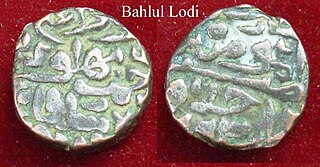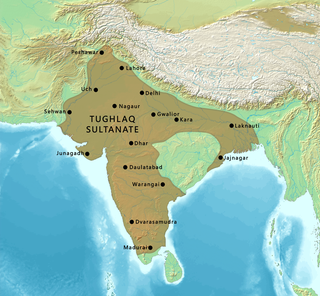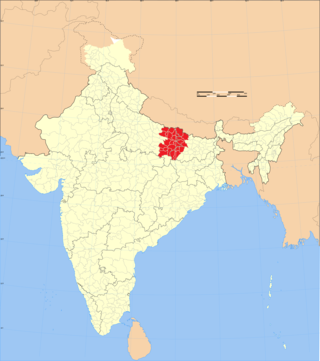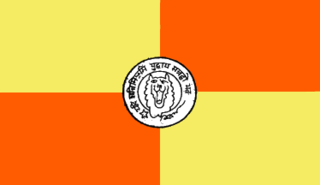
Muslim period in the Indian subcontinent is conventionally said to have started in 712, after the conquest of Sindh and Multan by the Umayyad Caliphate under the military command of Muhammad ibn al-Qasim. It began in the Indian subcontinent in the course of a gradual conquest. The perfunctory rule by the Ghaznavids in Punjab was followed by Ghurids, and Sultan Muhammad of Ghor is generally credited with laying the foundation of Muslim rule in Northern India.

The Delhi Sultanate or the Sultanate of Delhi was a late medieval empire primarily based in Delhi that stretched over large parts of the Indian subcontinent, for 320 years (1206–1526). Following the invasion of South Asia by the Ghurid dynasty, five dynasties ruled over the Delhi Sultanate sequentially: the Mamluk dynasty (1206–1290), the Khalji dynasty (1290–1320), the Tughlaq dynasty (1320–1414), the Sayyid dynasty (1414–1451), and the Lodi dynasty (1451–1526). It covered large swaths of territory in modern-day India, Pakistan, and Bangladesh as well as some parts of southern Nepal.

Sher Shah Suri, often referred to as Sultan Adil, was the founder of the Sur Empire in India. He was the regent and later sole ruler of Bihar from 1529—1540 until he defeated the Mughal Empire in 1540, founding the Sur Empire, and establishing his rule in Delhi, crowning himself as Emperor. After his accidental death in 1545 CE, his son Islam Shah became his successor. The influence of his innovations and reforms extended far beyond his brief reign. In his reign, he remained undefeated in battle, being renowned as one of the most skillful Afghan generals ever produced.

Bahlul Khan Lodi was the chief of the Afghan Lodi tribe. Founder of the Lodi dynasty from the Delhi Sultanate upon the abdication of the last claimant from the previous Sayyid rule. Bahlul became sultan of the dynasty on 19 April 1451.

The Tughlaq dynasty was the third dynasty to rule over the Delhi sultanate in medieval India. Its reign started in 1320 in Delhi when Ghazi Malik assumed the throne under the title of Ghiyath al-Din Tughluq. The dynasty ended in 1413.

The Lodi dynasty was a dynasty that ruled the Delhi Sultanate from 1451 to 1526. It was the fifth and final dynasty of the Delhi Sultanate, and was founded by Bahlul Khan Lodi when he replaced the Sayyid dynasty.
Mahmud Begada or Mahmud Shah I was the most prominent Sultan of the Gujarat Sultanate. Raised to the throne at young age, he successfully captured Pavagadh and Junagadh forts in battles which gave him his name Begada. He established Champaner as the capital.

The Jaunpur Sultanate was a late medieval Indian Muslim state which ruled over much of what is now the states of Uttar Pradesh and Bihar between 1394 and 1494. It was founded in 1394 by Khwajah-i-Jahan Malik Sarwar, an eunuch slave and former wazir of Sultan Nasiruddin Muhammad Shah IV Tughluq, amidst the disintegration of the Delhi Sultanate's Tughlaq dynasty. Centred in Jaunpur, the Sultanate extended authority over a large part of the Ganges-Yamuna Doab. It reached its greatest height under the rule of Sultan Ibrahim Shah, who also vastly contributed to the development of Islamic education in the Sultanate. In 1494, Sultan Hussain Khan was defeated by the forces of the Afghan ruler Bahlul Lodi, Sultan of the Lodi dynasty of the Delhi Sultanate at Benares at which point Hussain fled to Kahalgaon in modern-day Bihar where the Sultan of Bengal assigned him a pargana. Here he was allowed to mint his own coins and was promised help from Bengal in recovering his kingdom. He died in 1505.

The Gujarat Sultanate or Sultanate of Guzerat was a late medieval Indian kingdom in Western India, primarily in the present-day state of Gujarat. The kingdom was established in 1394 when Muzaffar Shah I, the Governor of Gujarat, declared independence from the Tughlaq dynasty of Delhi.

The Paramara Dynasty ruled Malwa and surrounding areas in west-central India between 9th and 14th centuries. They belonged to the Parmara clan of the Rajputs.

Bhojpur is a ethnolinguistic and cultural area in the Indian subcontinent where the Bhojpuri language is spoken as a mother tongue. The Bhojpuri region encompasses parts of the Indian states of Bihar, Uttar Pradesh, and Jharkhand, and the Madhesh, Gandaki and Lumbini provinces of Nepal.

Ujjainiya is a clan of Rajputs found in Bihar and Purvanchal. The Ujjainiya dynasty historically ruled over the parts of Bhojpuri region during the medieval era. They were mainly rulers and aristocrats holding major power of the region.
Purbiya was a common term used in medieval India for Rajput and Brahmin mercenaries and soldiers from the eastern Gangetic Plain - areas corresponding to present-day western Bihar and eastern Uttar Pradesh. The Purbiyas played a significant role in the militaries of various principalities in Western India including the Marwar army as well at the Gujarat Sultanate and Malwa Sultanate.

Muzaffar Shah I, born Zafar Khan, was the founder of the Muzaffarid dynasty in Medieval India, reigning over the Gujarat Sultanate from 1391 to 1403 and again from 1404 to 1411. The Kumbalgarh inscription says that Kshetra Singh defeated and captured Zafar Khan, King of Patan and the Khan remain in imprisonment with other Rajas.

The Bengal–Jaunpur confrontation was an early 15th-century conflict that stemmed from the Jaunpur Sultanate's opposition to the overthrowing of the Bengal Sultanate's founding dynasty, the Ilyas Shahi, by Raja Ganesha. After diplomatic pressure from the Timurid and Ming empires and direct combat support of Shivasimha, the King of Mithila. Jaunpur's sultan Ibrahim Shah Sharqi was convinced to abstain from attacking Bengal.
Rajputs in Bihar are members of the Rajput community living in the eastern Indian state of Bihar. They traditionally formed part of the feudal elite in Bihari society. Rajputs were pressed with the Zamindari abolition and Bhoodan movement in post-independence India; along with other Forward Castes, they lost their significant position in Bihar's agrarian society, leading to the rise of Other Backward Classes (OBCs).

The Dumraon Raj was a semi-autonomous principality located in the Bhojpuri region of the Indian state of Bihar which was ruled by the Ujjainiya dynasty. In the British era, they had the status of fedual rulers and excercised autonomous control over their territory. The name Dumraon Raj came from the capital town of Dumraon.

Bhojpur Kadim is a historic village in Dumraon block of Buxar district, Bihar, India. As of 2011, its population was 18,243, in 3,024 households. Together with the neighboring Bhojpur Jadid, it lends its name to the surrounding Bhojpuri region.
Raja Gajpati Ujjainia, also known as Raja Gajpati Sahi was a ruler of Bhojpur belonging to the Ujjainiya dynasty.

Nasir-ud-Din Mahmud Shah Sharqi or Mahmud Shah Sharqi was the 4th ruler of the Jaunpur Sultanate, reigned from 1440 to 1457. He succeeded his father Ibrahim Shah Sharqi as sultan and was known for his bravery and generosity. Mahmud suppressed internal rebellions and expanded his territories, defeating neighboring empires in the process. He consolidated a larger area through battles with strong neighboring empires, ultimately advancing the Jaunpur Sultanate.Haig, Wolseley (1928). The Cambridge History of India. Vol. III. Cambridge University Press. pp. 228–230, 252–253.Mahmud Shah Sharqi ruled over a vast area that included regions adjoining Bihar, Jharkhand, Uttar Pradesh, parts of Bengal, Nepal, Gondwana, Madhya Pradesh, and Odisha.
















